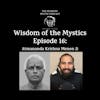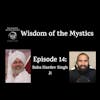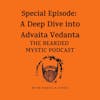Wisdom of the Mystics: Sri Ramakrishna Paramhamsa
In this episode, The Bearded Mystic Podcast discusses the wisdom of the great mystic Sri Ramakrishna Paramhamsa, who practiced all the world religions and found that they all lead to the same One! This is the magnificent guru of Swami Vivekananda and is a mystic that continues to inspire today. His integration of serving others in this transactional reality with the non-dual reality makes him a unique spiritual master.
I hope you enjoyed listening to the Wisdom of the Mystics series and if you are interested in listening to more episodes about Non-Duality and a deep dive into the Bhagavad Gita, please follow/subscribe to this Podcast.
Listen to this episode ad-free and support The Bearded Mystic Podcast and get extra content on Apple Subscriptions and Patreon.
https://www.patreon.com/thebeardedmysticpodcast
Join The Bearded Mystic Podcast Discussion Group: https://chat.whatsapp.com/GcCnyrjQwLuEPHBaVA6q9L
If you would like a one on one meeting with me via Zoom, find the details here:
https://calendly.com/thebeardedmysticpodcast/1on1meetings
Please rate and write a review for this Podcast on https://www.thebeardedmysticpodcast.com/reviews/new/
If you would like to attend a free weekly meditation with me, join my Whatsapp group:
https://chat.whatsapp.com/DcdnuDMeRnW53E0seVp28b
Subscribe to the free monthly The Bearded Mystic Newsletter: http://thebeardedmysticpodcast.substack.com
You can find links to Live Streams, Podcast, Videos etc: https://linktr.ee/thebeardedmysticpodcast
You can follow me and contact me on social media:
Website: https://www.thebeardedmysticpodcast.com/
Whatsapp Group: https://chat.whatsapp.com/GcCnyrjQwLuEPHBaVA6q9L
TikTok: https://vm.tiktok.com/ZMdk3HPJh/
Discord: https://discord.gg/4DbureZw8y
Instagram: https://www.instagram.com/thebeardedmysticpodcast/
Youtube: https://www.youtube.com/c/TheBeardedMysticPodcast/
Twitter: https://twitter.com/bearded_mystic
Facebook: https://www.facebook.com/The-Bearded-Mystic-Podcast
Can all the strange, weird, sometimes inexplicable happenings in our life be real? ...
Listen on: Apple Podcasts Spotify
Support the showHello, and welcome to another episode of The Bearded Mystic Podcast and I'm your host, Rahul N. Singh. Thank you for taking out the time today to either watch or listen to this podcast episode. Today, we will be continuing on with the Wisdom of the Mystic series. And before we do start, there's a few announcements that I would like to make. If you would like to support the Bearded Mystic Podcast, you can sign up to the Podcast's Patreon page for ad free and bonus episodes. The details are in the show notes and be the description below. And another way you can sign up to those ad free and bonus episodes is through the Apple subscriptions on the Apple Podcast app itself. Every Saturday there's a free virtual meditation session
that takes place at 11:00 AM Eastern Standard Time and this meditation session is then followed by a Q and A and discussion, and you can find out the details in this show notes and video description below. If you would like to have a one on one meeting with me over Zoom as a friend to help you on your spiritual path. You can find the details in these show notes and video description below. Last month we looked at the teachings of Shree Anandmayi Maa, and today in this episode, we will be looking at the teachings of a great Mystic, that was really a true synthesizer of all faiths, and that is Sri Ramakrishna Paramhamsa I will be looking at a few of his sayings and then giving you my contemplations upon those very teachings. The first quote. It is the veil of Maya that keeps God hidden from our sight. The universal soul or Paramatma cannot be realized till his veil is removed. The sun lights up the earth, but a small cloud will hide it from our view. Similarly, the insignificant veil of Maya prevents us from knowing the omnipresent and all witness, Sat-Chit-Ananda Existence-Consciousness-Bliss. Now a very interesting quote, and let's break this down a little, and it's very clear here that it is Maya, this transactional reality that hides this Formless reality from us. We see this world and we start thinking that this is real because through the instrument of our senses, we feel that all of this is the only reality. However, until we remove this veil, only then can we see what our true self is or what the Ultimate Reality is. So Nirguna Brahman is always there. Now, how can we actually experience this? Well, if we understand that everything that we see and perceive is basically changing, and as you know from this second chapter of The Bhagavad Gita that anything that changes is ultimately unreal, it is asat. If that is the base of everything, then what we need to inquire even further is, well, what is changeless then? Because it is said again in that same chapter that the only thing that is real is that which does not change. Well, if we think about it from our own direct experience, that while we go throughout our day, all through the years that we've lived, there's been something within us that has been watching everything that has remained untouched by every experience and by every sense projection. For example, in happiness and sadness, pain and pleasure, it seems to be that our awareness is the one thing that remains changeless. This is what it is meant here that this Atman can only be realized, this Nirguna Brahman is when we remove that veil of Maya. Once we take away and negate everything that changes, then what's left is our own awareness or as Rupert Spira would say " being aware of being aware". Now, for example a metaphor is used here that the Sun lights up the earth, but a small cloud will hide it from our view. Now, it doesn't mean that the sun is not present. It's present there always, but a cloud then covers it. Likewise, the Self-luminuous Nirguna Brahman is always there. But sometimes the, the cloud of sense projections, of thoughts, of images, of conditioning, of our vasanas all these things can cloud up that Self luminous Nirguna Brahman, which is our Essential Self. And that's why Sri Ramakrishna says in the next part, that similarly, the veil of maya is insignificant. It's insignificant why? Because it's essentially unreal, prevents us from seeing the omnipresent. Again, omnipresent meaning the only thing that's really present. Yeah. Omni meaning only one. And present meaning present. So the only thing present is this Nirguna Brahman and all witnessing. So remember, it's the all observing Self, the all observing Sat-Chit-Ananda. Existence Consciousness Bliss because the base, the substratum of all existence is Nirguna Brahman. It's essential nature is of Consciousness. As the all witnessing, remember, the all observing and it's nature is bliss because there is nothing that takes it away from bliss because this bliss is uncreated. The nature of that substratum is bliss. So that's how we can live a happy life always when we get in touch with the all witnessing Sat-Chit-Ananda.
Now the second quote is:Brahman cannot be explained by words. As a man called upon to give an idea of the ocean to a person who has never seen it, can only say "it is a vast sheet of water, a big expanse of water, it is water - water all round." So one who has realized Brahman can only say " Brahman, Brahman is everywhere." What a beautiful quote and think about this. For example, in the very first line, he says that Brahman cannot be explained by words, and this is very true. In order to really understand Brahman this Attribute-less Ultimate Reality, the only way to do this is actually by going into direct experience. When we go from the background of awareness and we bring it to the forefront, we get rid of the veil of Maya, negate it all away, so only Nirguna Brahman remains. That's why if you had to explain the ocean to somebody, you will say there's only water all around. Likewise, to show the vastness of existence, of the substratum of existence, we have to say that Brahman is everywhere. Brahman is all pervading. Brahman is the only thing that is. Now, if this becomes our experience, then everything we see, perceive through our senses hear, taste, smell, touch is essentially Brahman. So can there ever be a moment where you are away from Brahman, where you are untouched by Brahman? No. Even in this very second, in this very moment itself. While you are listening to this, while I'm speaking here, only Brahman is witnessing Brahman, and to understand this truth, again, it has to be our experience. Merely saying this is not enough, merely hearing it is not enough. We have to truly become Aware of this Awareness. We truly have to allow what J Krishnamurti said, which was when the observer becomes the observed. When we live in this state, then we are always in touch with Brahman, but not as Brahman being something separate that there's still a separate me and a separate Brahman. No, there is only Brahman. Truly, this is what is meant by 'Aham Brahmasmi' when there is only Brahman, when they only see this Formless Awareness. When this Formless Awareness is the only thing, then Aham Brahmasmi is said. Aham Brahmasmi is not something that can be said prematurely, and neither should it be taken as something prematurely. The real meaning is when there is only Brahman, when there is only this Formless Awareness. When you're in touch with this Brahman, it is an experience that one cannot express in words. Words cannot do justice to the magnificence. of this Brahman. I rarely talk about how I feel when I'm in that connection with Brahman or in Brahman. When I'm in that moment of being aware of being aware. But all I can tell you is there is nothing like it. I've not come across any experience has even come to a close second to that, it's the primary experience that really only exists and it's not that one does not take part in the transactional reality. One obviously is. I'm recording this podcast right now, but the transactional reality is seen as just an, an activity of Brahman. Even though this does not act yet, it appears to be an activity in Brahman. Truly this is the beauty of Sri Ramakrishna's teachings because he brings across an advaita vedanta philosophy that makes it so all encompassing. We don't see Maya something evil or something that should be rejected, but instead we accept it to be part of Brahman. In fact, we accept it as being Brahman, therefore everything we do is in the service of Brahman and we see each and every person as Brahman. Yes. That does not mean that evil will be eradicated or poverty will be eradicated, or we will not be able to get rid of caste or race issues or people that like to separate us due to whatever ' isms' possible. All those will still be there, but that does not mean that we cannot see Brahman in everything. Yeah, it's a very tough pill to swallow. But once we are able to actually do this, we can understand, with discernment that we have to address the transactional reality as real, only because it's the infinite time of Brahman. Every action I do personally has a real consequence in the infinite nature of maya that is only a reflection of Brahman. By integrating these two - Brahman and maya, I'm able to do the best possible and this is why Sri Ramakrishna is absolutely special and that's why I really love him. One thing may be raised because someone can turn around to me who's read the gospel of Sri Ramakrishna and say, Well, he talks about women and gold in a very derogatory way, or sometimes in a way, which is not all encompassing, but, sometimes the translation is not right. Sometimes the translation can be too literal and not looking at the deeper meaning behind it. So, for example, when he says women, he's actually talking about lust. And when he talks about gold, he's talking about wealth and power and our attachments. Basically he's got those five vices that are mainly talked about, pleasure, anger, greed, attachment, pride, and ego. All of those things are encompassed in what he says, ' gold and women'. But really the main essence are those five. I just want us to understand that because sometimes people can raise an objection, but they don't really understand the real meaning behind what is being said.
The third quote is:As the water and its bubbles are one - for the bubble, has its birth in water, floats on water, and is ultimately resolved into water. So the Jivātman and the Paramātman are in essence one and the same. The difference is that while one is finite and small, the other is infinite, while one is dependent, the other is independent. It is like a doll of salt trying to fathom the depths of the ocean. In doing so, the salt doll is dissolved into the sea and lost. Similarly, the Jiva, in trying to measure God, loses its individuality and becomes one with it. What a beautiful quote by Sri Ramakrishna, and again, so simple to understand. If we see ourselves as separate beings, then we can consider ourselves to be like bubbles in the ocean At the end of the day the bubbles are going to merge back into the ocean because it is the ocean itself. It's not anything different. This is exactly what Sri Ramakrishna is saying here. If we understand that the Jiva and Paramatman are one and the same, then it's basically saying what Adi Shankara Ji said that Brahma satyam jagat mithya, jivo brahmaiva naparah. That this Brahman is the only true existence. This jagat this world, this maya is mithya. It's neither real nor unreal because it's dependent on how one is dealing with that Ultimate Reality. And then this jiva this underlying essence within us, this observer within us, this witness within us, that Consciousness within us is actually Brahman itself. There's no difference between it. And then he explains that although one is finite and small, the other is infinite. Once we understand that, yes okay this body and mind is a finite expression of the Infinite, which is bodiless and Formless. And therefore transcends all those things that would restrict it and limit it. Then our field of observation, the field of the observer becomes all pervading, everlasting, infinite. There's no beginning to it, there's no end to it, and that is our True Nature. Once we understand that the essence is one and the same, spirituality becomes so much easier. One cannot express then how easy spirituality is to understand. Then he uses the example of the salt doll that is dissolved in the sea. Now say there is a doll made out of salt and says that "Well, I want to measure the ocean. I want to check how vast the ocean is." As it goes into the ocean to try to measure the whole ocean, what ends up happening. That salt dissolves. And we see this when we are cooking, when we put salt into boiling water. We see how the salt dissolves away, and likewise, if the jiva ever went out to measure Brahman, it will lose its individuality because as it starts measuring, it starts immersing itself, and as it immerses, it merges. Therefore, how can the form of the jiva last when eventually it will enter into formlessness. When it understands its essence is the same as that Brahman and loses it's individual expression and goes into the universal expression, then we can call that mukti. Then we see that as oneness , and what a beautiful way that Sri Ramakrishna explains this. It is such a simple way but it brings the message of advaita vedanta in such a strong foundation, and he expresses it so perfectly that anybody can understand. Then the fourth quote. As when going to a strange country, one must abide by the directions of one who knows the road. While taking the advice of many would lead to confusion, so in trying to reach Brahman, one should follow implicitly the advice of a single Guru who knows a way to God. Who can be another's Guru? Brahman alone is the Guru and master of the universe. Now, these are two quotes that I merged into one, but let's address the first part of the quote. That as when going to a strange country, one must abide by the directions of one who knows the road while taking the advice of many would lead to confusion. So think about this logically. Say you go to a different country, with a group of friends or your family, and everyone is a driver and everyone takes out their mobile phone. One is using Google Maps, one is using Apple Maps. Someone is using Waze. Someone's using a different app and they're all giving their directions, all having different route or routes, as they say, in America to the same place. Now, if the driver ends up listening to each and every one of them, there's going to be confusion. Now, the alternative here is that the driver can explore each app itself. So asking each passenger to give their directions. Now, that is one way where they can go from place A to B. Similarly, if you utilize this example for a Guru, I'm all for going to different gurus and understanding the truth. But what I will say, and there's a big caveat here, is that stick to one for some good amount of time. See if that teacher will take you to the truth. Now, it may be that you need to spend a year. But in today's day and age, with the advent of technology and the fact that you can now speak to anybody over Zoom or watch on YouTube, I think you can cut it down to six months. Where you can spend six months of consuming one guru's content to see if it takes you to the truth. And go to a Guru that really speaks to you. Now if say you listen to several different gurus at one time, it will cause confusion for you because one Guru is specified in one tradition, another Guru in another tradition, and another Guru in another tradition. Now, if you try to follow each of those traditions, it will become a soup of disaster because you will be confused and what's the point of that? I agree with Sri Ramakrishna that you don't have to stick with a Guru forever. There's no need to be loyal to someone that's not taking you closer to the truth, or someone who does not know the scriptures or who doesn't know what it's like to live a spiritual life. Now, there are many Gurus out there that have got their position through one way or another, and that's why it's up to you to see the merits of a Guru. So likewise, see the merits spend time, then make your conclusion and don't ever feel guilty if you don't believe in a particular Guru, it's fine. At the end of the day, you have to make sure that the person you follow doesn't have a criminal record, doesn't have controversies that they've not addressed, that they are not there because of being part of a particular family or because of nepotism in any way. That's not saying that a child of a Guru cannot become the Guru itself most likely, you know, if they've stayed in that spiritual community, in that home, have been inspired by the teachings of the Guru, they themselves may become great examples and therefore great successors to that organization and to that spiritual institution. But just be mindful, I would say. The best thing to do is try and find your way to God by following one Guru at least for six months before you make your conclusion to either stay or leave. Now, Sri Ramakrishna adds another thing, and this is why it's important, that once you have found the Truth, then make the Truth your Guru. Make the Brahm Gyana your Guru, make Brahman your Guru. Then don't follow the body. The body and mind has served its purpose once the truth is revealed to you, then you have to stick with the Truth and make the Truth your Guru, then you have to be obedient to the Truth. Yeah, you have to serve the Truth. This Ultimate Brahm Gyana that's what you do and that's what Sri Ramakrishna means here when he says, who can be another's guru? Brahman alone is the Guru and Master of the universe. For there is only Brahman. Therefore, if you start believing that the body and mind of someone is Paramatman or is God or is Brahman, then we fall under illusion. Then we will see the body and mind, the limited expression as the Truth, and we will fall under another delusion. That's why it's really important that we see Brahman as our Guru. Once we have found the Truth, once we have rested in Formless Awareness, once we can automatically bring the background of Formless Awareness to the forefront at any time, then that means that Brahman is now our Guru, our Master, our True Teacher, our Satguru.
The fifth quote is:Gyana yoga means communion with Brahman by means of Gyana, of knowledge. The Gyani's object is to realize Brahman, the Absolute. He says “Not this” “Not this,” Neti Neti and thus leaves out of account one unreal thing after another until he gets to a point where all vichara or discernment between the Real and the unreal ceases, and the Absolute Brahman is realized in Samadhi. So what is Samadhi first of all? Samadhi is that when we are only in Formless Awareness. Where only Formless Awareness is. When that is the omnipresent, the only thing present. Now, that's what Gyana yoga is. Gyana yoga is that when the whole object of anything we do is to realize Brahman, to realize the Absolute. So how do we do this? A method has been given here by Sri Ramakrishna, and that is to go through the process of Neti Neti and this has been utilized since the Upanishads, and therefore, it's a process we can all use and definitely go behind as a solid process, as a solid method. We do this by getting rid of anything that is unreal. Anything that changes, we take it away. As I mentioned earlier, until we come to that point where all the unreal ceases to be, where we get rid of all that which is unreal, and in that Absolute state only Brahman is there, Self-luminous, Self-revealing, Self-sustaining, Self existent Brahman. That is the only thing that is, and that's what Sri Ramakrishna means here. A very interesting verse, and again, one that has a method in and the one that tells us what Samadhi really is. Yeah, that's the easiest way to Samadhi when we were able to go through the process of neti neti and this has been used by Sri Ramana Maharshi, obviously Sri Ramakrishna, Swami Vivekananda, and so many countless other nondual teachers have expressed and shown the importance of the process and the method of Neti Neti of "not this, not this." The sixth quote is an interesting one again and one that will require our vichara of, we need to contemplate upon this. Suppose there is an infinite expanse of water, water above, water beneath, water in all directions. At certain times of the year this water freezes with cold, and again, when the days are warm, it thaws and becomes water. Brahman is like the infinite, expanse of water. Those parts that are frozen into ice are the spiritual Personal Forms of the Deity, or known as the ishtha-devta. The cold is the bhakti of the devotee, his love, his devotion, his self-surrender. The heat again is Gyana-vichara discernment between the Real and the unreal phenomenal universe or maya), leading up to Nirvikalpa Samadhi, the total effacement or absorption of the Self which says, "I", "I". To a bhakta the Lord manifests itself in various forms. The one who reaches the height of Brahm Gyana in Samadhi, it is the Nirguna Brahman once more, Formless (Nirakara), Unconditioned. Herein is a reconciliation between Gyana and Bhakti. The beauty of Sri Ramakrishna is that he doesn't see Gyana and bhakti as two separate things. He sees them as one and the same. For bhakti, for devotion, you need Gyana and for Gyana you need devotion. You need heart, you need love, you need compassion. You need acceptance. You need surrender because only when we surrender this "I', this ego, do we then allow Brahman to shine forth. Sri Ramakrishna again uses the analogy of water to explain how we can utilize an ishta-devta, a form or a deity that can help us in our spirituality. Now, it may be easy to allow ourselves to surrender to a personal form, to a Deity whether that is Shiva ji, whether that's Sri Krishna, whether that's Buddha, whether that's Guru Nanak Dev ji, whether that's your Guru that you worship. Anybody. Remember that they are just the form of ice, And that through listening to the teachings, through meditation on the Ishta-devta through worship of the Ishta-devta through devotion of the ishta-devta, what we do is, we slowly allow, as we go deeper into the absorption of Nirguna Brahman, as we go through our devotion of the ishta-devta, through Saguna Brahman, we start seeing that that ice starts melting away, and we enter into Nirvikalpa Samadhi or total absorption into Nirguna Brahman, where Nirguna Brahman is the only thing. And this is Sri Ramakrishna's beautiful message that we've constantly seen here. We need to do two things. One with the aid of a deity or a Guru or a mantra, anything that will help create that love and devotion and self-surrender, and then using the Gyana-Vichara of what is real and unreal, what is permanent and impermanent, by utilizing those things, we'll be able to go to the Formless. We'll be able to go to the Nirguna Brahman, which is essentially what we are and therefore that makes it a lot easier for us and a process that we can go behind. This is an easier way as well where we utilize both Gyana and Bhakti. The seventh and final quote of the day. Unique is that realization, where there is neither teacher nor pupil. Brahma-Gyana, or the Knowledge of Brahman is that state of oneness where remains no distinction between Guru and disciple. Now, the reason why I'm ending it on this quote itself is that this is the real realization. That there is only Brahman and therefore the Guru and discipleship has to dissolve away in order for the Absolute Truth to take its Absolute place in the heart. A Guru never restricts us to their form and never allows us to remain stuck on being the disciple. The Guru will always guide us to go beyond all relationships to enter into that state of realization. Brahm Gyana as he mentioned, is that state of oneness. Anything that takes us to that oneness is Brahm Gyana, is the knowledge of Brahman. One thing that we emphasize here in our podcast is that we need to embrace Brahm Gyana in order to become one as Brahman. If we would sum up the whole teaching of Sri Ramakrishna and his philosophy is that there are infinite paths to realization. What we need to understand is how to create a synthesis between this world and Formless Awareness and the way to do that is to go back to Sat-Chit-Ananda and understand that the substratum of all existence, of all maya is Brahman and the only thing present is Consciousness and it's nature is blissfulness, is ecstasy, is happiness and this is ultimately what Sri Ramakrishna experienced. Those that knew about his life and we have recollections of that. We've read the works of Swami Vivekananda and we know for a fact that Sri Ramakrishna was a unique personality that practiced all of the world religions, whether that was Islam, Christianity, Sikhism, Hinduism, Buddhism, any faith he came across, he followed completely and realized that they all take us to the Supreme Being, which is Brahman. The main aim is to become totally absorbed in Brahman. But we are not to neglect the world. We are to serve each other as Brahman itself. We are to see that same Witness Consciousness in each and every person. We are to help others as much as possible. We are to alleviate poverty. We are to make sure that everyone in society is treated fairly and is treated With absolute justice. I hope that you've enjoyed this episode. Let me know about your thoughts of Sri Ramakrishna. Do you have any doubts about him or do you want to express your gratitude towards him? Let me know in the comments below in this video or let me know on social media how you feel about Sri Ramakrishna's message and this is the end of the episode. Please do share this podcast with your friends and family who may enjoy this content. Do follow me on social media to keep getting updates or subscribe to the monthly Bearded Mystic newsletter, or you can join the Bearded Mystic Podcast WhatsApp group, and those details are in the show notes and video description below. If you would like to support the Bearded Mystic podcast, do check out the podcast's Patreon page, or you can support the podcast through Apple Podcast subscriptions, and you can find that on the Apple Podcast app itself. The rest of the details are in the show notes and video description below. If you would like to have a one-on-one meeting with me as a friend to discuss your spirituality, you can find the details in the show notes and video description below. Please do rate and review the podcast on the website, www.thebeardedmysticpodcast.com. Please do like and comment on this video and subscribe to this YouTube channel, or do follow and subscribe to this podcast on your favorite podcast streaming app, or the one that you're listening to this on right now. Thank you very much for listening. Let's end with feeling the peaceful nature of this Formless Awareness. Aum Shanti Shanti, Shanti Aum, Peace Peace. Peace Namaste
New to The Bearded Mystic Podcast?
Here are some great episodes to start with. Or, check out episodes by topic.















